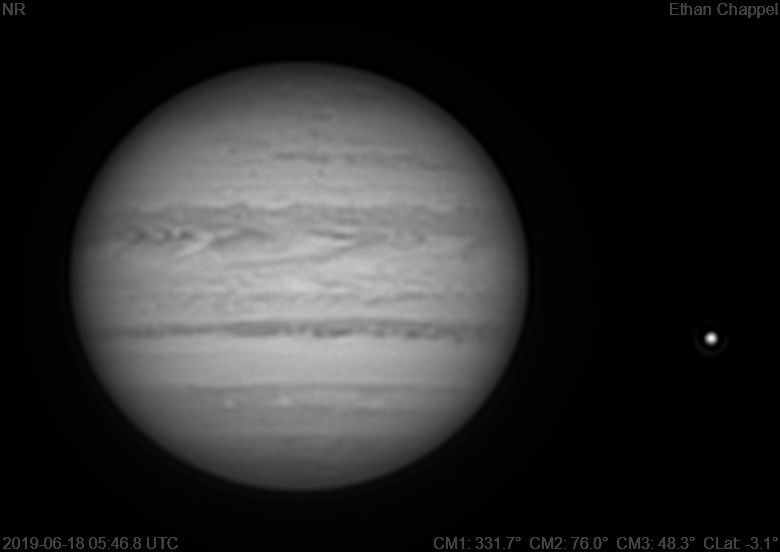
Jupiter UTC
CM1: 331.70°
CM2: 76.00°
CM3: 48.30°
CLat: -3.10°
Description
After capturing some RGB sets, I decided to catch some deep-red/infrared photons from Jupiter.
Notes:
- The Equatorial Zone, unusually orange in visible light, appears normal in this wavelength.
- The northern South Equatorial Belt is lighter than normal.
- The SEBs appears dark and clumpy.
- Io is approaching Jupiter from the right.
Equipment
ZWO ASI290MM
Astro-Physics Advanced Convertible Barlow
Celestron EdgeHD 8
Logs
FireCapture v2.6 Settings ------------------------------------ Observer=Ethan Chappel Camera=ZWO ASI290MM Filter=IR Profile=Jupiter Diameter=45.90" Magnitude=-2.61 CMI=330.6° CMII=74.9° CMIII=47.2° (during mid of capture) FocalLength=3750mm (F/13) Resolution=0.16" Filename=2019-06-18-0545_0-EC-IR-Jup.ser Date=2019_06_18 Start=05_44_05.315 Mid=05_45_05.315 End=05_46_05.315 Start(UT)=05_44_05.315 Mid(UT)=05_45_05.315 End(UT)=05_46_05.315 Duration=120.000s Date_format=yyyy_MM_dd Time_format=HH_mm_ss LT=UT -6h Frames captured=5998 File type=SER Binning=no Bit depth=8bit Debayer=no ROI=828x424 ROI(Offset)=0x0 FPS (avg.)=49 Shutter=20.00ms Gain=290 (48%) Brightness=1 (off) AutoGain=off USBTraffic=40 (off) HighSpeed=off Gamma=50 AutoHisto=75 (off) SoftwareGain=10 (off) FPS=100 (off) AutoExposure=off Histogramm(min)=0 Histogramm(max)=109 Histogramm=42% Noise(avg.deviation)=0.77 AutoAlign=false PreFilter=none Limit=120 Seconds Sensor temperature=32.6°C FireCapture v2.6 Settings ------------------------------------ Observer=Ethan Chappel Camera=ZWO ASI290MM Filter=IR Profile=Jupiter Diameter=45.90" Magnitude=-2.61 CMI=332.7° CMII=77.0° CMIII=49.3° (during mid of capture) FocalLength=3750mm (F/13) Resolution=0.16" Filename=2019-06-18-0548_6-EC-IR-Jup.ser Date=2019_06_18 Start=05_47_36.072 Mid=05_48_36.075 End=05_49_36.078 Start(UT)=05_47_36.072 Mid(UT)=05_48_36.075 End(UT)=05_49_36.078 Duration=120.006s Date_format=yyyy_MM_dd Time_format=HH_mm_ss LT=UT -6h Frames captured=5998 File type=SER Binning=no Bit depth=8bit Debayer=no ROI=828x424 ROI(Offset)=0x0 FPS (avg.)=49 Shutter=20.00ms Gain=290 (48%) Brightness=1 (off) AutoGain=off USBTraffic=40 (off) HighSpeed=off Gamma=50 AutoHisto=75 (off) SoftwareGain=10 (off) FPS=100 (off) AutoExposure=off Histogramm(min)=0 Histogramm(max)=106 Histogramm=41% Noise(avg.deviation)=0.78 AutoAlign=false PreFilter=none Limit=120 Seconds Sensor temperature=32.5°C